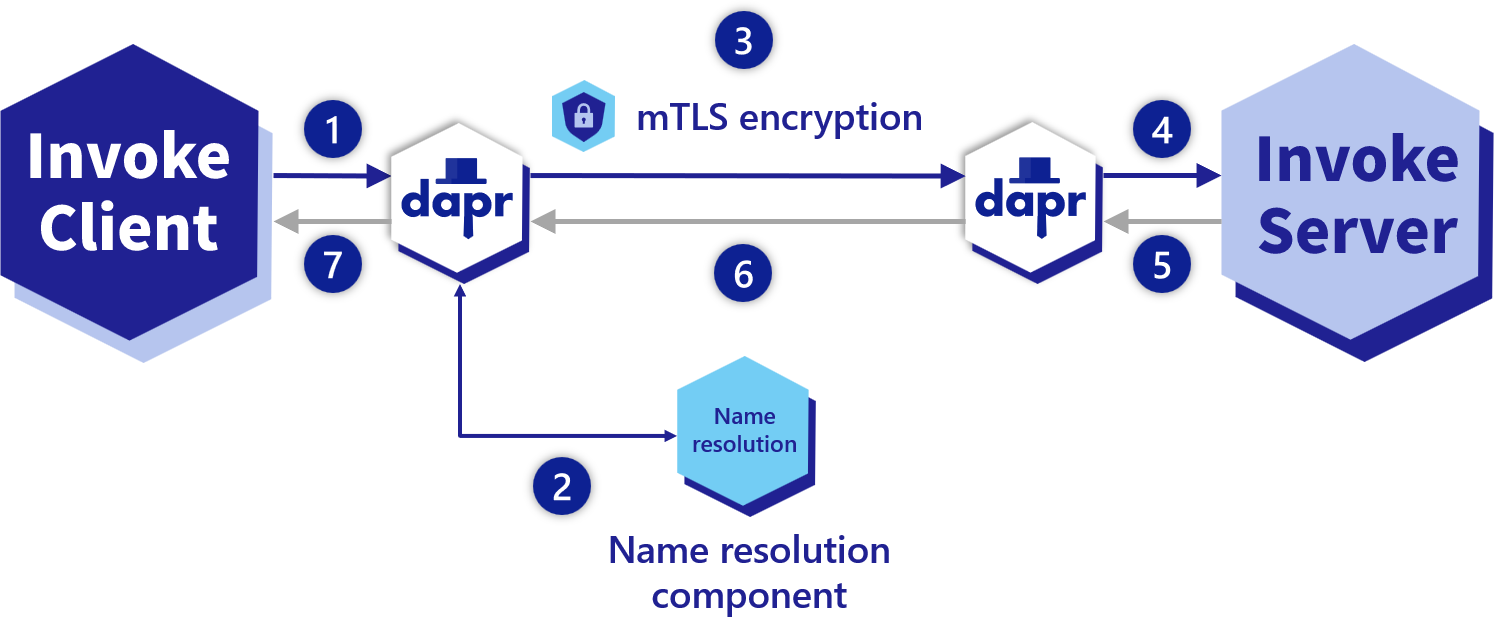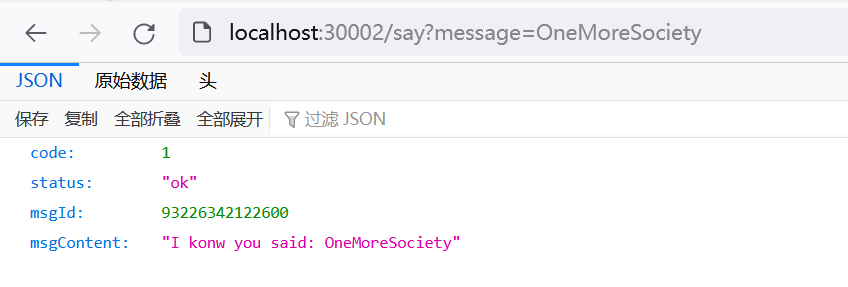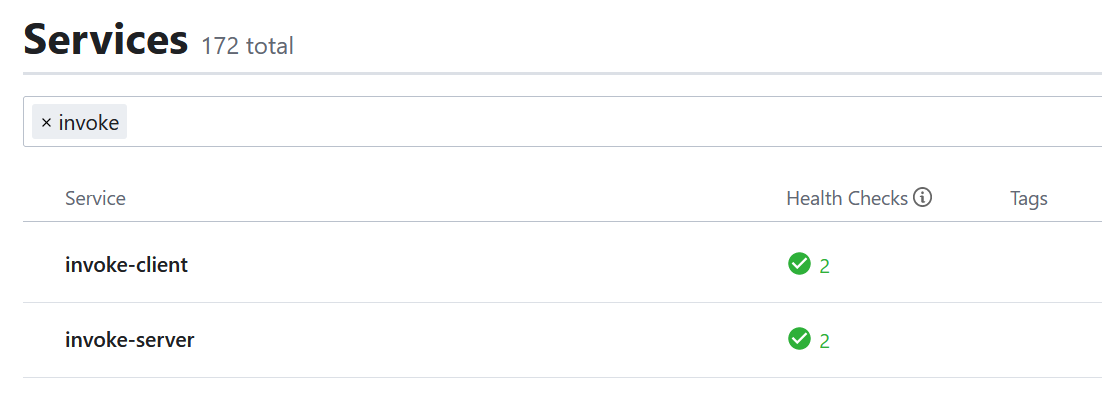Dapr在Java中的實踐 之 服務呼叫
服務呼叫
通過服務呼叫(Service-to-service Invocation),服務可以使用 gRPC 或 HTTP 這樣的標準協定來發現並可靠地與其他服務通訊。
Dapr採用邊車(Sidecar)、去中心化的架構。 要使用Dapr來呼叫服務,可以在任意Dapr範例上使用invoke這個API。 邊車程式設計模型鼓勵每個服務與自己的Dapr範例對話。 Dapr範例會相互發現並進行通訊。
文章持續更新,微信搜尋「萬貓學社」第一時間閱讀,關注後回覆「電子書」,免費獲取12本Java必讀技術書籍。
建立專案
建立兩個SpringBoot專案,分別命名為:invoke-server和invoke-client。invoke-server作為下游服務,被invoke-client呼叫,具體呼叫過程如下圖:

呼叫過程包括:
invoke-client服務對invoke-server服務發起HTTP或gRPC呼叫的時候,存取invoke-client服務的Dapr範例。invoke-client服務的Dapr範例通過執行在給定託管平臺上服務名解析元件(Name Resolution Component)發現了執行在此Dapr環境中的invoke-server服務。invoke-client服務的Dapr範例將訊息轉發到服務invoke-server服務的Dapr範例。Dapr範例之間的所有呼叫考慮到效能都優先使用gRPC。 僅服務與Dapr範例之間的呼叫可以是HTTP或gRPC。invoke-server服務的Dapr範例將請求轉發至invoke-server服務上的特定端點或方法,隨後執行其業務邏輯程式碼。invoke-server服務返回響應資訊給invoke-client服務時,響應資訊給將轉至invoke-server服務的Dapr範例。invoke-server服務的Dapr範例訊息轉發至invoke-client服務的Dapr範例。invoke-client服務接收到其Dapr範例的響應資訊。
文章持續更新,微信搜尋「萬貓學社」第一時間閱讀,關注後回覆「電子書」,免費獲取12本Java必讀技術書籍。
編寫invoke-server的程式碼
呼叫/send介面時,返回對應資訊,主要程式碼如下:
package one.more.society.invoke.server;
import lombok.extern.slf4j.Slf4j;
import org.springframework.web.bind.annotation.RequestBody;
import org.springframework.web.bind.annotation.RequestMapping;
import org.springframework.web.bind.annotation.RequestMethod;
import org.springframework.web.bind.annotation.RestController;
@Slf4j
@RestController
public class InvokeServerController {
@RequestMapping(value = "/send", method = RequestMethod.POST)
public InvokeResponse send(@RequestBody InvokeRequest request) {
log.info("send - request:{}", request);
InvokeResponse response = new InvokeResponse();
response.setCode(1);
response.setStatus("ok");
response.setMsgId(System.nanoTime());
response.setMsgContent("I konw you said: " + request.getMsgContent());
return response;
}
}
其中,InvokeRequest和InvokeResponse的原始碼如下:
package one.more.society.invoke.server;
import lombok.Data;
@Data
public class InvokeRequest {
private Long msgId;
private String msgContent;
}
package one.more.society.invoke.server;
import lombok.Data;
@Data
public class InvokeResponse {
private int code;
private String status;
private Long msgId;
private String msgContent;
}
在application.properties中設定:
server.port=30001
文章持續更新,微信搜尋「萬貓學社」第一時間閱讀,關注後回覆「電子書」,免費獲取12本Java必讀技術書籍。
編寫invoke-client
在invoke-client專案的pom.xml檔案中新增如下依賴:
<dependency>
<groupId>io.dapr</groupId>
<artifactId>dapr-sdk-springboot</artifactId>
<version>1.4.0</version>
</dependency>
<dependency>
<groupId>com.squareup.okhttp3</groupId>
<artifactId>okhttp</artifactId>
<version>4.9.3</version>
</dependency>
注入一個DaprClient的bean:
@Configuration
public class DaprConfig {
private static final DaprClientBuilder BUILDER = new DaprClientBuilder();
@Bean
public DaprClient buildDaprClient() {
return BUILDER.build();
}
}
呼叫invoke-server的/send介面,主要程式碼如下:
package one.more.society.invoke.client;
import io.dapr.client.DaprClient;
import io.dapr.client.domain.HttpExtension;
import lombok.extern.slf4j.Slf4j;
import org.springframework.beans.factory.annotation.Autowired;
import org.springframework.web.bind.annotation.RequestMapping;
import org.springframework.web.bind.annotation.RequestMethod;
import org.springframework.web.bind.annotation.RestController;
@Slf4j
@RestController
public class InvokeClientController {
@Autowired
private DaprClient client;
private static final String SERVICE_APP_ID = "invoke-server";
private static final String METHOD_NAME = "send";
@RequestMapping(value = "/say", method = RequestMethod.GET)
public InvokeResponse say(String message) {
log.info("send - message:{}", message);
InvokeRequest request = new InvokeRequest();
request.setMsgId(System.nanoTime());
request.setMsgContent(message);
InvokeResponse response = client.invokeMethod(
SERVICE_APP_ID,
METHOD_NAME,
request,
HttpExtension.POST,
InvokeResponse.class).block();
return response;
}
}
其中,InvokeRequest、InvokeResponse的原始碼與invoke-server中是一樣的。
在application.properties中設定:
server.port=30002
文章持續更新,微信搜尋「萬貓學社」第一時間閱讀,關注後回覆「電子書」,免費獲取12本Java必讀技術書籍。
啟動服務
在啟動之前先用mvn命令打包:
mvn clean package
在invoke-server專案的目錄中執行以下命令,啟動invoke-server服務:
dapr run --app-id invoke-server --app-port 30001 --dapr-http-port 31001 -- java -jar target/invoke-server-0.0.1-SNAPSHOT.jar
在invoke-client專案的目錄中執行以下命令,啟動invoke-client服務:
dapr run --app-id invoke-client --app-port 30002 --dapr-http-port 31002 -- java -jar target/invoke-client-0.0.1-SNAPSHOT.jar
在Dapr Dashboard中看到:

兩個服務都已經啟動成功。
存取http://localhost:30002/say?message=OneMoreSociety驗證整個呼叫流程:

可以看到服務之間的呼叫沒有問題,並返回了預想的結果。
文章持續更新,微信搜尋「萬貓學社」第一時間閱讀,關注後回覆「電子書」,免費獲取12本Java必讀技術書籍。
名稱解析元件
為了啟用服務發現和服務呼叫,Dapr使用可插拔的名稱解析元件。 Kubernetes名稱解析元件使用Kubernetes DNS服務來解析叢集中執行的其他服務的位置;自託管機器可以使用mDNS名稱解析元件。
Consul名稱解析元件可以在任何託管環境中使用,包括Kubernetes或自託管環境。下面讓我們來嘗試一下,使用Consul作為名稱解析元件。
在使用者目錄下的.dapr資料夾中,找到config.yaml檔案。在該檔案中,新增一個nameResolution的spec ,並將component欄位設定為consul,比如:
apiVersion: dapr.io/v1alpha1
kind: Configuration
metadata:
name: daprConfig
spec:
nameResolution:
component: "consul"
configuration:
client:
address: "127.0.0.1:8500"
selfRegister: true
重新啟動服務,可以在紀錄檔中看到註冊到了Consul上:
time="14:28:54.4540593+08:00" level=info msg="service:invoke-client registered on consul agent" app_id=invoke-client instance=OneMoreSociety scope=dapr.contrib type=log ver=1.7.3
time="14:28:54.4550937+08:00" level=info msg="Initialized name resolution to consul" app_id=invoke-client instance=OneMoreSociety scope=dapr.runtime type=log ver=1.7.3
在Consul中也可以看到兩個服務都已經註冊上去了,如下圖:

值得注意的是:Consul名稱解析元件目前還處於Alpha狀態,最好不要在生產環境使用。
更詳細的設定說明見下表:
| 設定項 | 是否必填 | 資料型別 | 說明 | 範例 |
|---|---|---|---|---|
| client | N | Config | 設定使用者端與 Consul 代理的連線。 如果留空,將使用預設值,即127.0.0.1:8500 | 192.168.0.111:8500 |
| queryOptions | N | QueryOptions | 設定用於解決健康服務的查詢,預設為UseCache:true |
UseCache: false, Datacenter: "myDC" |
| checks | N | AgentServiceCheck陣列 | 當進行註冊服務時,設定健康檢查。預設到Dapr範例檢測健康端點。 | |
| tags | N | string陣列 | 在註冊服務服務時包含的額外標籤 | - "dapr" |
| meta | N | string字典 | 在註冊服務服務時包含的額外的後設資料 | DAPR_METRICS_PORT: "${DAPR_METRICS_PORT}" |
| daprPortMetaKey | N | string | 用於在服務解析過程中從Consul服務後設資料中獲取Dapr範例埠的 key,它也將用於在註冊時在後設資料中設定Dapr範例埠。 預設為 DAPR_PORT | "DAPR_TO_DAPR_PORT" |
| selfRegister | N | boolean | 控制Dapr範例是否會向Consul註冊服務,預設為 false | true |
| advancedRegistration | N | AgentServiceRegistration | 通過設定完全控制服務註冊結果。 如果設定此項,Checks、 Tags、 Meta 和 SelfRegister的任何設定將被忽略。 |
設定範例:
apiVersion: dapr.io/v1alpha1
kind: Configuration
metadata:
name: appconfig
spec:
nameResolution:
component: "consul"
configuration:
client:
address: "127.0.0.1:8500"
selfRegister: true
checks:
- name: "Dapr Health Status"
checkID: "daprHealth:${APP_ID}"
interval: "15s",
http: "http://${HOST_ADDRESS}:${DAPR_HTTP_PORT}/v1.0/healthz"
- name: "Service Health Status"
checkID: "serviceHealth:${APP_ID}"
interval: "15s",
http: "http://${HOST_ADDRESS}:${APP_PORT}/health"
tags:
- "dapr"
- "v1"
- "${OTHER_ENV_VARIABLE}"
meta:
DAPR_METRICS_PORT: "${DAPR_METRICS_PORT}"
DAPR_PROFILE_PORT: "${DAPR_PROFILE_PORT}"
daprPortMetaKey: "DAPR_PORT"
queryOptions:
useCache: true
filter: "Checks.ServiceTags contains dapr"
最後,感謝你這麼帥,還給我點贊。
微信公眾號:萬貓學社
微信掃描二維條碼
關注後回覆「電子書」
獲取12本Java必讀技術書籍


出處:http://www.cnblogs.com/heihaozi/
版權宣告:本文遵循 CC 4.0 BY-NC-SA 版權協定,轉載請附上原文出處連結和本宣告。
微信掃描二維條碼,關注萬貓學社,回覆「電子書」,免費獲取12本Java必讀技術書籍。